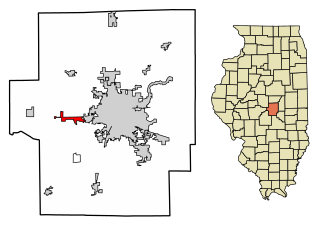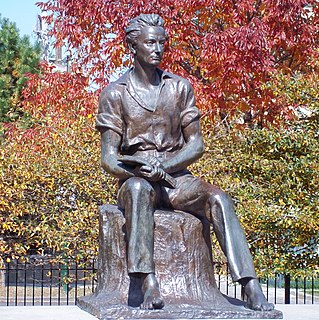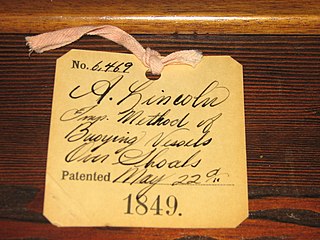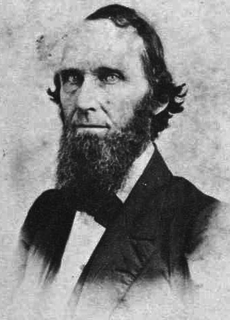Related Research Articles

The Illinois River is a principal tributary of the Mississippi River and is approximately 273 miles (439 km) long. Located in the U.S. state of Illinois, the river drains a large section of central Illinois, with a drainage basin of 28,756.6 square miles (74,479 km2). The drainage basin extends into Wisconsin, Indiana, and a very small area of southwestern Michigan.

Sangamon County is a county located in the center of the U.S. state of Illinois. According to the 2010 census, it had a population of 197,465. Its county seat and largest city is Springfield, the state capital.

Harristown is a village in Macon County, Illinois, United States whose population was 1,367 at the 2010 census. It is included in the Decatur, Illinois Metropolitan Statistical Area.

Lincoln's New Salem State Historic Site is a reconstruction of the former village of New Salem in Menard County, Illinois, where Abraham Lincoln lived from 1831 to 1837. While in his twenties, the future U.S. President made his living in this village as a boatman, soldier in the Black Hawk War, general store owner, postmaster, surveyor, and rail splitter, and was first elected to the Illinois General Assembly.

The Sangamon River is a principal tributary of the Illinois River, approximately 246 miles (396 km) long, in central Illinois in the United States. It drains a mostly rural agricultural area between Peoria and Springfield. The river is associated with the early career of Abraham Lincoln and played an important role in early European settlement of Illinois, when the area around was known as the "Sangamon River Country". The section of the Sangamon River that flows through Robert Allerton Park near Monticello was named a National Natural Landmark in 1971.
George Washington Glasscock was an early settler, legislator, and businessman in Texas.

The Alton Railroad was the final name of a railroad linking Chicago to Alton, Illinois; St. Louis, Missouri; and Kansas City, Missouri. Its predecessor, the Chicago and Alton Railroad, was purchased by the Baltimore and Ohio Railroad in 1931 and was controlled until 1942 when the Alton was released to the courts. On May 31, 1947, the Alton Railroad was merged into the Gulf, Mobile and Ohio Railroad. Jacob Bunn had been one of the founding reorganizers of the Chicago & Alton Railroad Company during the 1860s.

Abraham Lincoln was born on February 12, 1809, in a one-room log cabin on the Sinking Spring farm, south of Hodgenville in Hardin County, Kentucky. His siblings were Sarah Lincoln Grigsby and Thomas Lincoln, Jr. After a land title dispute forced the family to leave in 1811, they relocated to Knob Creek farm, eight miles to the north. By 1814, Thomas Lincoln, Abraham's father, had lost most of his land in Kentucky in legal disputes over land titles. In 1816, Thomas and Nancy Lincoln, their nine-year-old daughter Sarah, and seven-year-old Abraham moved to what became Indiana, where they settled in Hurricane Township, Perry County, Indiana.
The Illinois Historic Preservation Division, formerly Illinois Historic Preservation Agency, is a governmental agency of the U.S. state of Illinois, and is a division of the Illinois Department of Natural Resources. It is tasked with the duty of maintaining State-owned historic sites, and maximizing their educational and recreational value to visitors or on-line users. In addition, it manages the process for applications within the state for additions to the National Register of Historic Places.
Illinois Route 125 (IL-125) is a major 37.10 miles (59.71 km) highway in the central portion of the U.S. state of Illinois. Illinois 125 runs east from the concurrent U.S. Route 67 and Illinois Route 100 near Beardstown to Illinois Route 97 in Farmingdale, west of Springfield.

The Vandalia State House, built in 1836, is the fourth capitol building of the U.S. state of Illinois. It is also the oldest capitol building in Illinois to survive, as the first, second, and third capitol buildings have all disappeared. The brick Federal style state house has been operated by the state of Illinois as a monument of Illinois pioneer years since 1933. It is located in Vandalia, Illinois, on the National Road, and listed on the National Register of Historic Places.

The Lincoln Log Cabin State Historic Site is an 86-acre (0.3 km²) history park located eight miles (13 km) south of Charleston, Illinois, U.S., near the town of Lerna. The centerpiece is a replica of the log cabin built and occupied by Thomas Lincoln, father of U.S. President Abraham Lincoln. Abraham Lincoln never lived here and only occasionally visited, but he provided financial help to the household and, after Thomas died in 1851, Abraham owned and maintained the farm for his stepmother, Sarah Bush Lincoln. The farmstead is operated by the Illinois Historic Preservation Agency.

The Lincoln Trail Homestead State Park and Memorial is a 162-acre (66 ha) state park located on the Sangamon River in Macon County near Harristown, Illinois, United States.
James D. Henry was a militia officer from the U.S. state of Illinois who rose to the rank of general during the Black Hawk War. Henry was born in Pennsylvania in 1797, and moved to Edwardsville, Illinois in 1822. In 1825, while living in Edwardsville, he was indicted with two other men for the murder of an acquaintance, though he never went to trial. One defendant was tried but found not guilty, and following the trial Henry moved to Springfield, Illinois, where he was elected sheriff. When the Winnebago War broke out in 1827 Henry acted as adjutant for four companies of volunteers.

Abraham Lincoln served as a volunteer in the Illinois Militia April 21, 1832 – July 10, 1832, during the Black Hawk War. Lincoln never saw combat during his tour but was elected captain of his first company. He was also present in the aftermath of two of the war's battles, where he helped to bury the militia dead. He was mustered in and out of service during the war, going from captain to private and finishing his service in an independent spy company commanded by Captain Jacob Early.

Colonel Edmund Dick Taylor was an American businessman, politician, and soldier from Illinois. He is remembered as the first person to suggest that the United States should issue paper currency ("greenbacks") during the American Civil War.

Abraham Lincoln's patent relates to an invention to lift boats over shoals and obstructions in a river. It is the only United States patent ever registered to a President of the United States. Lincoln conceived the idea of inventing a mechanism that would lift a boat over shoals and obstructions when on two different occasions the boat on which he traveled got hung up on obstructions. The original documentation of this patent was rediscovered in 1997.
The Chicago real estate bubble of the 1830s was a real estate bubble, during which time the per acre prices in the future Chicago Loop increased from $800 in 1830 to $327,000 in 1836, before falling to $38,000 per acre by 1841. The Bank of Illinois began foreclosing on large amounts of real estate in the aftermath of the bust before it declared bankruptcy in 1842.
Clayville is a former roadside hamlet, inhabited from 1824 into the 1850s, located in Cartwright Township near Pleasant Plains, Illinois, United States. The settlement was never large but was firmly centered on a once-thriving tavern on the main road between Springfield, the state capital, and the Illinois River port of Beardstown. The Broadwell Tavern continues to stand on its original foundation today as a reminder of the once-active frontier settlement.

Ozias Mather Hatch was an American politician. He was the 13th Illinois Secretary of State, serving under William Henry Bissell, John Wood, and Richard Yates Sr. During the governorship of Wood, Hatch handled most of the duties of Governor of Illinois.
References
- 1 2 3 Howard, Robert P. (July 21, 2007). "New Eden: The Pioneer Era in Sangamon County". Springfield, Illinois: Sangamon County Historical Society. Archived from the original on 2007-07-21. Retrieved 2020-05-27.
- ↑ "December 1835". The Lincoln Log: A Daily Chronology of the Life of Abraham Lincoln. Archived from the original on October 8, 2007. Retrieved 2020-05-27. in an older version.
- ↑ "February 1836". The Lincoln Log: A Daily Chronology of the Life of Abraham Lincoln. Archived from the original on August 21, 2008. Retrieved 2020-05-27. in an older version.